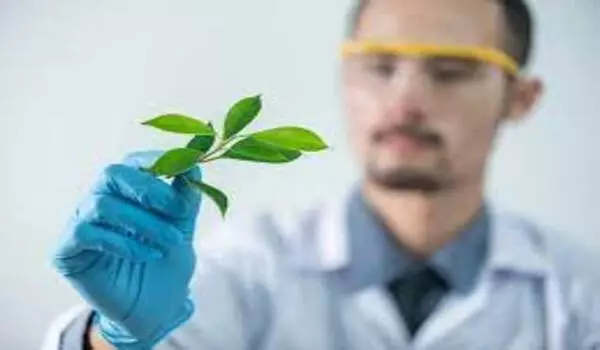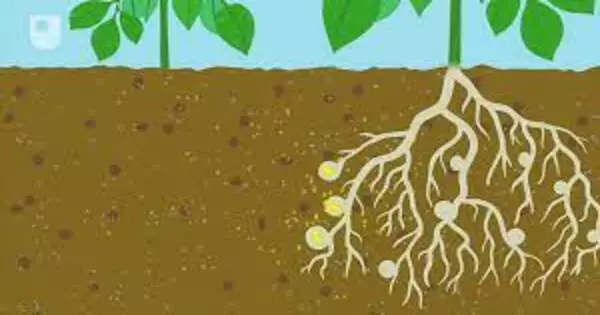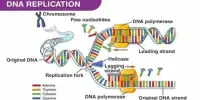Research into the relationships between bacteria and plants has revealed that specific bacteria can play an important role in supporting plant development and general health. Scientists discovered that competition between types of beneficial bacteria in the soil reduces the service that the bacteria provide to their hosts.
Plants create alliances with bacteria in the soil in which they thrive. Legumes, for example, benefit from a symbiotic relationship with microorganisms that live in nodules in their roots and “fix” nitrogen in the atmosphere to make it available for the legumes’ growth. But are microorganisms usually good to plants? Or does competition among strains for plant access diminish the function that bacteria eventually provide?
A team led by scientists at the University of California, Riverside, set up experiments to answer these questions and better understand the competition process. The researchers used a native California plant with nodules, Acmispon strigosus, and a set of eight compatible nitrogen-fixing bacterial strains. They infected some plants with each of the eight strains to directly measure their ability to infect the plants and provide benefits. They then infected other plants with pairs of bacterial strains to assess the competitive ability of each strain and the effect on plant performance.
Our models showed that co-inoculated plants got much lower benefits from symbiosis than what could be expected from the clonal infections. While beneficial bacteria work well in the lab, they get out-competed in the natural environment.
Arafat Rahman
The researchers discovered that competition between types of helpful bacteria in the soil reduces the service provided by the bacteria to their hosts.
“More specifically, we found that interstrain competition that occurs in the soil before the bacteria infect the plant causes fewer bacteria to colonize the plant, resulting in the plant gaining smaller benefits in the end,” said Joel Sachs, a professor of evolution, ecology, and organismal biology who led the research team.
“To understand symbiosis, we often use sterile conditions where one strain of bacteria is ‘inoculated’ or introduced into an otherwise sterile host. Our experiments show that making that system slightly more complex – simply by using two bacterial strains at a time – fundamentally shifts the balance of benefits that the hosts receive, reshaping our understanding of how symbiosis works.”
Study results appear in the journal Current Biology.
Sachs explained that exploiting the benefits that microorganisms may bring to crops by boosting growth in a sustainable way without the environmental costs of chemical fertilizers is a key challenge in agriculture. His lab investigates rhizobia, which are microorganisms that encourage plant development. Rhizobial competition has long been a source of concern for sustainable agriculture. Rhizobia bacteria generate root nodules on legumes, where they fix nitrogen for the plant in return for carbon from photosynthesis. Growers have long sought to use rhizobia to fertilize staple legume crops such as soybeans, peanuts, peas, and green beans in a sustainable manner.

“One might think using rhizobia as inoculants should allow growers to minimize the use of chemical nitrogen, which is environmentally damaging,” said Sachs, who chairs the Department of Evolution, Ecology, and Organismal Biology. “But such rhizobial inoculation is rarely successful. When growers inoculate their crops with high-quality rhizobia – strains that fix a lot of nitrogen – these ‘elite’ strains get outcompeted by indigenous rhizobia that are already in the soil and provide little or no benefit to hosts.”
Sachs and his colleagues employed previously sequenced genomes of bacterial strains in their investigations. They also characterized the strains, which ranged from highly advantageous to inefficient at nitrogen fixation, in order to determine their exact benefit to the target plant species. The scientists sequenced the contents of almost 1,100 nodules from plants infected with one of 28 distinct strain combinations.
Following that, the researchers created mathematical models to anticipate how much benefit co-inoculated plants would get based on what they expected from plants that were “clonally infected” (infected with a single strain). This enabled the researchers to determine the growth deficit caused by interstrain competition.
“Our models showed that co-inoculated plants got much lower benefits from symbiosis than what could be expected from the clonal infections,” said Arafat Rahman, a former graduate student in Sachs’ lab and the first author of the research paper. “While beneficial bacteria work well in the lab, they get out-competed in the natural environment. Ultimately, we want to find a strain of bacteria – or a set of them – that gives maximum benefit to the host plant and is competitive against bacterial strains that are already in the soil.”
According to Sachs, in order to uncover and cultivate a bacterial strain that is highly favorable to plants, scientists must conduct tests under extremely clean conditions.
“Ultimately, we want to use beneficial bacteria in agriculture,” he explained. “Typically, we would add one bacterial strain to a plant in the lab and show that the plant grows much better with the strain than without.” However, in the field, the plant is covered in microorganisms, confounding the picture. In our trials, we progressed from utilizing a single strain to employing two strains to evaluate what effect this had on plant growth. Surprisingly, with only two strains, many of our forecasts failed.”
Rahman emphasized that while trials are required to determine how advantageous a bacterial strain is, research that evaluate how competitive the strain is against a panel of other bacterial strains are also required.
“Both steps are crucial,” he said. “Our research discovered that some of the best strains can be highly beneficial to plant growth, but when combined with any other strain, that benefit is greatly reduced.” Furthermore, it is critical to understand when the interstrain competition takes place: before or after the bacteria interact with the plant. Our findings support the former and provide a good direction for future trials aimed at uncovering strains that are superior for delivery in crops.”
According to Sachs, the focus of many recent experimental designs is on the benefit to plants.
“It’s important to remember, however, that bacteria are shaped by natural selection,” he stated. “Some of them may be highly competitive in entering the nodule to infect the plant but not very beneficial to the plant, and that may be a trait that prevails in nature.” We need to understand interstrain dynamics in microbial communities if we are to leverage them for the services they can bring to plants and animals.”















